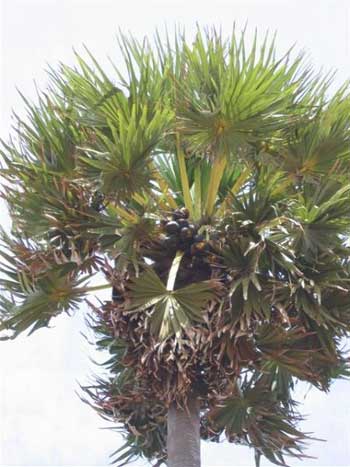Hidden treasures of palmyrah
By Natasha Gunaratne
 With so much emphasis being put on the development of the coconut industry in Sri Lanka, the benefits of the lesser known palmyrah, most commonly found in the north east and north west of the country was the focus of a presentation given by Professor E.R Jansz when he was awarded the distinguished gold medal at the Bernard Soysa Memorial Oration this past week. With so much emphasis being put on the development of the coconut industry in Sri Lanka, the benefits of the lesser known palmyrah, most commonly found in the north east and north west of the country was the focus of a presentation given by Professor E.R Jansz when he was awarded the distinguished gold medal at the Bernard Soysa Memorial Oration this past week.
Jansz, a lecturer in biochemistry at the University of Sri Jayawardenapura, holds a PhD and has had a long and distinguished career in the field of chemistry with over 15 years dedicated to internationally published research. On Bernard Soysa, the former Minister of Science and Technology, said he was not the 'stereotypical politician of today' but was instead 'quiet, unassuming, honest and a master of literature' who did not amass wealth during his eminent political career. Jansz added that the University of Sri Jayawardenapura, has been wholly supportive of his career and his research endeavours and that more institutions should allow freedom for scientists to research meaningful subjects, such as palmyrah, which has the potential to be a great national treasure with prospects for commercialization.
Palmyrah mostly grows in the semi arid zones of East Africa, South Asia, South East Asia and Palmyra Island in the South Pacific. However, most of Jansz's research was conducted in Sri Lanka and so far, his team of researchers under his guidance has uncovered many uses for this plant. In Sri Lanka, palmyrah is mostly native to Jaffna, Mannar and Kalpitiya but he says the 'situation is tragic' in these areas. In the Jaffna Peninsula, broken palmyrah is a feature of the landscape and is commonly used for bunkers. Kalpitiya faces a similar situation where changes in the landscape, due in part to human activities, have resulted in palmyrah being replaced with coconuts.
"Although the North and South have problems and cultural differences, scientists are on the best of terms," he said, adding that the most promising palmyrah plantations can be found in the Hambantota district. Palmyrah products range from sugar and toddy related products to odiyal flour, fibre, handicrafts and even building materials. Most products are bitter and Jansz attributes this to the unique constituents in its materials. His research has focused on the underused palmyrah fruit pulp whose main constituents are sugar, pectin, saponins and carotenoids. His first challenge when he started out in palmyrah research was to de-bitter the fruit pulp for creating beverages.
Through his research, Jansz was able to identify the compound which caused the bitterness as Flabelliferin II but found that once products were de-bittered, they spoiled easily. After more research conducted on mice, Jansz and his team noticed that the mice who were given the bitter fruit pulp experienced weight loss whereas those given the non-bitter fruit pulp showed none. It was discovered that Flabelliferin II was preventing the absorption of glucose into the blood stream with no adverse reactions. In order to further this add credibility to these findings, Jansz performed long term and short term studies on 20 mild diabetic humans by administering them six grams of Pinnatu per day. The results were remarkable as the individuals had a 28 – 35% decline in serum glucose. Jansz said this is certainly a prospect for commercialization. Further research uncovered that the fruit pulp can also act as an antibiotic, another prospect for commercialization.
Pectin, one of the constituents of palmyrah fruit pulp is 'commercially usable' and can garner Rs.1000 per kilo, said Jansz adding that research has shown a 25 – 35% lowering of blood cholesterol in mice. However, there was no effect on lowering cholesterol levels when the same mice were given Pinnatu. Carotenoids, another constituent of the fruit pulp has the potential to be 'commercially significant as food colour over synthetic dyes', the latter most commonly found in food and drink today.
Odiyal flour is produced from palmyrah seed shoot and is found to be neurotoxic. One of Jansz's researchers, by accident found that if heated to 80 degrees Celsius for 15 – 20 minutes, toxicity is greatly reduced. Since odiyal flour is widely consumed, there is no appearance of the toxicity to be found in humans even though the toxin in present during food preparation. "Humans may have a detoxification mechanism," Jansz said. Western studies into palmyrah have also been used for commercial purposes, according to Jansz. He cited two such studies which found palmyrah used as steroid for anti-cancer effects and immunosuppressive effects. "Sure there are more discoveries to come and have led to unique chemical features," he said. "The private sector should turn these findings to help the people."
|
|

 With so much emphasis being put on the development of the coconut industry in Sri Lanka, the benefits of the lesser known palmyrah, most commonly found in the north east and north west of the country was the focus of a presentation given by Professor E.R Jansz when he was awarded the distinguished gold medal at the Bernard Soysa Memorial Oration this past week.
With so much emphasis being put on the development of the coconut industry in Sri Lanka, the benefits of the lesser known palmyrah, most commonly found in the north east and north west of the country was the focus of a presentation given by Professor E.R Jansz when he was awarded the distinguished gold medal at the Bernard Soysa Memorial Oration this past week.